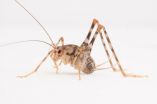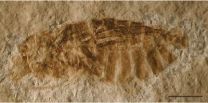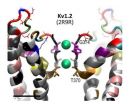(Press-News.org) BOSTON (September 2, 2014) — In the battle between our immune systems and cholera bacteria, humans may have an unknown ally in bacteria-killing viruses known as phages. In a new study, researchers from Tufts University, Massachusetts General Hospital, Partners In Health, Haiti's National Public Health Laboratory, and elsewhere, report that phages can force cholera bacteria to give up their virulence in order to survive. Importantly, the study — published in eLife — found that cholera's mutational escape from phage predation occurs during human infection.
First author Kimberley Seed, Ph.D., and corresponding author Andrew Camilli, Ph.D., both of Tufts University School of Medicine, and their co-authors analyzed phage resistance properties and DNA sequences of cholera bacteria taken from phage-positive stool samples from patients with cholera in Haiti and Bangladesh, two countries where cholera outbreaks are common at present.
They first determined that cholera bacteria from Haiti changed its DNA in order to fight phages. They compared the bacteria from Haiti to bacteria from Bangladesh collected over many years to determine if the changes were happening on multiple occasions in both countries or only in isolated groups or cases.
The research team discovered that across both time and geography, the cholera bacteria mutated during human infection in order to trade their virulence, or ability to persist and make a human sick, for the ability to defend against the phages. Alternatively, in some patients, the cholera bacteria mutated in a more conservative manner to retain virulence, yet sacrificed the ability to grow optimally in the environment. In either scenario, the cholera bacteria appear to have traded something important in order to survive the onslaught from phages.
"This is the first time we have seen cholera bacteria defend themselves from phages while infecting humans. This suggests that these phages are actively working in our favor, first by killing cholera bacteria within the patient, and second, by genetically weakening the bacteria that are shed by the infected patient such that they are less fit to survive in the environment or less able to cause infection in other people," said senior author Andrew Camilli, a Howard Hughes Medical Institute investigator, professor of molecular biology & microbiology at Tufts University School of Medicine, and member of the Molecular Microbiology program faculty at the Sackler School of Graduate Biomedical Sciences at Tufts University.
"This important finding suggests that we may be able to leverage the strength of phages for treating people with cholera or perhaps preventing cholera in people who may have been recently exposed as an alternative to antibiotics," he continued.
"Seeing this rapid evolutionary change in the cholera bacteria occurring during human infection suggests that the phages are posing a very strong threat. And to observe this in two different continents suggests that this is not a one-time find, but that it may be happening consistently during cholera outbreaks," said first author Seed, now assistant professor of molecular, cellular and developmental biology at University of Michigan. "Additionally, virtually all bacteria can be infected by phages, which are found wherever bacteria are. So this finding with cholera may be the start of a broader understanding of how phages and bacteria evolve."
Previous work by Camilli and Seed, published last year in Nature, provided the first evidence that a phage could acquire a wholly functional and adaptive immune system. They observed that the phage could use this acquired immune system to disarm a phage defense system of the cholera bacteria, allowing the phage to ultimately destroy its bacterial host. This study bolstered the concept of using phage to prevent or treat bacterial infections, and extended the idea that phages can be extremely sophisticated bacterial predators. The team is now investigating the details of this particular arms race between phage and bacteria in hopes of better understanding how phage influence cholera outbreaks and how we can further leverage phages to treat or prevent infections.
The World Health Organization reports that there are an estimated three-to five million cases of cholera cases and 100,000 to 120,000 deaths due to cholera each year. This summer, at least 67 people in Ghana have died of cholera while 6,000 others have been infected. In northern Cameroon, there are reports that 200 people have died and many more infected in the last few months. A current outbreak in South Sudan has taken 130 lives out of a total of more than 5,800 cases. In Haiti, since the beginning of the epidemic there (October 2010) and through March of this year, more than 8,500 people have died, out of more than 700,000 reported cases.
INFORMATION:
Additional authors are Minmin Yen, a Ph.D. student in the Molecular Microbiology program at the Sackler School of Graduate Biomedical Sciences; B. Jesse Shapiro, Ph.D., assistant professor of biology and chair of the Microbial Evolutionary Genomics lab at the Université de Montréal; Isabelle J. Hilaire, M.P.H., of Partners In Health; Richelle C. Charles, M.D., an assistant physician in the Division of Infectious Diseases at Massachusetts General Hospital, and assistant professor of medicine at Harvard Medical School; Jessica E. Teng, M.P.H., of Partners In Health and a research assistant in the Division of Global Health Equity at Brigham and Women's Hospital; Louise Ivers, M.D. M.P.H., DTM&H, of Partners In Health, associate physician in the Division of Global Health Equity at Brigham and Women's Hospital, and associate professor of medicine and of global health at Harvard Medical School; Jacques Boncy, M.D., director of Haiti's National Public Health Laboratory (Laboratoire National de Santé Publique), the reference laboratory center of Haiti's Ministry of Public Health and Population (Ministère de la Santé Publique et de la Population or MSPP), and professor of microbiology and laboratory medicine at the University of Haiti; and Jason Harris, M.D., an associate pediatrician and member of the pediatric infectious disease division at Massachusetts General Hospital, as well as an associate professor of pediatrics at Harvard Medical School.
Research reported in this publication was supported by the National Institute of Allergy and Infectious Diseases (NIAID) of the National Institutes of Health (NIH) under award number R01AI055058, as well as the Natural Sciences and Engineering Research Council of Canada and the Canada Research Chairs program via award number 950-228996. Kimberley Seed was also supported by the Charles A. King Trust Postdoctoral Research Fellowship Program. Additional funding was provided by the NIAID under award numbers R01AI099243 and K08AI089721.
Seed K.D., Yen M, Shapiro B.J., Hilaire I.J., Charles R.C., Teng J.E., Ivers L.C., Boncy J, Harris J.B., Camilli A. "Evolutionary consequences of intra-patient phage predation on microbial populations. eLife (August 26, 2014). DOI: http://dx.doi.org/10.7554/eLife.03497
For more information, read The DNA Thief, or New Study Shows Viruses Can Have Immune Systems.
About Tufts University School of Medicine and the Sackler School of Graduate Biomedical Sciences
Tufts University School of Medicine and the Sackler School of Graduate Biomedical Sciences at Tufts University are international leaders in innovative medical and population health education and advanced research. Tufts University School of Medicine emphasizes rigorous fundamentals in a dynamic learning environment to educate physicians, scientists, and public health professionals to become leaders in their fields. The School of Medicine and the Sackler School are renowned for excellence in education in general medicine, the biomedical sciences, and public health, as well as for innovative research at the cellular, molecular, and population health level. Ranked among the top in the nation, the School of Medicine is affiliated with six major teaching hospitals and more than 30 health care facilities. Tufts University School of Medicine and the Sackler School undertake research that is consistently rated among the highest in the nation for its effect on the advancement of medical and prevention science.
War between bacteria and phages benefits humans
Cholera bacteria sacrifice virulence to survive phages
2014-09-02
ELSE PRESS RELEASES FROM THIS DATE:
Migrating birds sprint in spring, but take things easy in autumn
2014-09-02
Passerine birds, also known as perching birds, that migrate by night tend to fly faster in spring than they do in autumn to reach their destinations. This seasonal difference in flight speed is especially noticeable among birds that only make short migratory flights, says researcher Cecilia Nilsson of Lund University in Sweden, in Springer's journal Behavioral Ecology and Sociobiology.
Nilsson, in a group led by professor Thomas Alerstam, used a tracking radar to measure over three years the speed by which birds flew over Falsterbo Peninsula, a bird migratory hot spot ...
Nano-forests to reveal secrets of cells
2014-09-02
Vertical nanowires could be used for detailed studies of what happens on the surface of cells. The findings are important for pharmaceuticals research, among other applications. A group of researchers from Lund University in Sweden have managed to make artificial cell membranes form across a large number of vertical nanowires, known as a 'nano-forest'.
All communication between the interior of a cell and its surroundings takes place through the cell membrane. The membrane is a surface layer that holds the cell together and that largely comprises lipids, built of fatty ...
Scientists find possible neurobiological basis for tradeoff between honesty, self-interest
2014-09-02
What's the price of your integrity? Tell the truth; everyone has a tipping point. We all want to be honest, but at some point, we'll lie if the benefit is great enough. Now, scientists have confirmed the area of the brain in which we make that decision.
The result was published online this week in Nature Neuroscience.
"We prefer to be honest, even if lying is beneficial," said Lusha Zhu, the study's lead author and a postdoctoral associate at the Virginia Tech Carilion Research Institute, where she works with Brooks King-Casas and Pearl Chiu, who are assistant professors ...
Researchers find Asian camel crickets now common in US homes
2014-09-02
With their long, spiky legs and their propensity for eating anything, including each other, camel crickets are the stuff of nightmares. And now research from North Carolina State University finds that non-native camel cricket species have spread into homes across the eastern United States.
"The good news is that camel crickets don't bite or pose any kind of threat to humans," says Dr. Mary Jane Epps, a postdoctoral researcher at NC State and lead author of a paper about the research.
The research stems from a chance encounter, when a cricket taxonomist found an invasive ...
Exceptionally well preserved insect fossils from the Rhône Valley
2014-09-02
In Bavaria, the Tithonian Konservat-Lagerstätte of lithographic limestone is well known as a result of numerous discoveries of emblematic fossils from that area (for example, Archaeopteryx). Now, for the first time, researchers have found fossil insects in the French equivalent of these outcrops - discoveries which include a new species representing the oldest known water treader.
Despite the abundance of fossils in the equivalent Bavarian outcrops, fewer fossils have been obtained from the Late Kimmeridgian equivalents of these rocks in the departments of Ain and Rhône ...
Surprising new role for calcium in sensing pain
2014-09-02
DURHAM, N.C. -- When you accidentally touch a hot oven, you rapidly pull your hand away. Although scientists know the basic neural circuits involved in sensing and responding to such painful stimuli, they are still sorting out the molecular players.
Duke researchers have made a surprising discovery about the role of a key molecule involved in pain in worms, and have built a structural model of the molecule. These discoveries, described Sept. 2 in Nature Communications, may help direct new strategies to treat pain in people.
In humans and other mammals, a family of ...
Single laser stops molecular tumbling motion instantly
2014-09-02
In the quantum world, making the simple atom behave is one thing, but making the more complex molecule behave is another story.
Now Northwestern University scientists have figured out an elegant way to stop a molecule from tumbling so that its potential for new applications can be harnessed: shine a single laser on a trapped molecule and it instantly cools to the temperature of outer space, stopping the rotation of the molecule.
"It's counterintuitive that the molecule gets colder, not hotter when we shine intense laser light on it," said Brian Odom, who led the research. ...
NYU study compares consequences of teen alcohol and marijuana use
2014-09-02
Growing public support for marijuana legalization in the U.S. has led to public debate about whether marijuana is "safer" than other substances, such as alcohol. In January, President Obama also publically stated he is not convinced that marijuana is more dangerous than alcohol. Despite the recent shift in views toward marijuana, the harms of use as compared to alcohol use are not well understood.
Now a new study "Adverse Psychosocial Outcomes Associated with Drug Use among US High School Seniors: A Comparison of Alcohol and Marijuana," by researchers affiliated with ...
Discovery hints at why stress is more devastating for some
2014-09-02
Some people take stress in stride; others are done in by it. New research at Rockefeller University has identified the molecular mechanisms of this so-called stress gap in mice with very similar genetic backgrounds — a finding that could lead researchers to better understand the development of psychiatric disorders such as anxiety and depression.
"Like people, each animal has unique experiences as it goes through its life. And we suspect that these life experiences can alter the expression of genes, and as a result, affect an animal's susceptibility to stress," says senior ...
Simple awareness campaign in general practice identifies new cases of AF
2014-09-02
Barcelona, Spain – Tuesday 2 September 2014: A simple awareness campaign in general practice identifies new cases of atrial fibrillation (AF), according to research presented at ESC Congress today by Professor Jean-Marc Davy from France.
Professor Davy said: "Atrial fibrillation (AF) is the most common cardiac arrhythmia. It multiplies the risk of heart failure risk by three-fold and the risk of stroke risk by five-fold. Similarly, AF is responsible for ischaemic stroke in 1 of 4 cases. However, AF is often overlooked and diagnosed too late. In 20% of cases, AF is diagnosed ...
LAST 30 PRESS RELEASES:
Study uncovers neural mechanisms underlying foraging behavior in freely moving animals
Gene therapy is halting cancer. Can it work against brain tumors?
New copper-catalyzed C-H activation strategy from Scripps Research
New compound from blessed thistle promotes functional nerve regeneration
Auburn’s McCrary Institute, ORNL to partner on first regional cybersecurity center to protect the nation’s electricity grid
New UNC-Chapel Hill study examines the increased adoption of they/them pronouns
Groundbreaking study reveals potential diagnostic marker for multiple sclerosis years before symptom onset
Annals of Internal Medicine presents breaking scientific news at ACP’s Internal Medicine Meeting 2024
Scientists discover new way to extract cosmological information from galaxy surveys
Shoe technology reduces risk of diabetic foot ulcers
URI-led team finds direct evidence of ‘itinerant breeding’ in East Coast shorebird species
Wayne State researcher aims to improve coding peer review practices
Researchers develop a new way to safely boost immune cells to fight cancer
Compact quantum light processing
Toxic chemicals from microplastics can be absorbed through skin
New research defines specific genomic changes associated with the transmissibility of the monkeypox virus
Registration of biological pest control products exceeds that of agrochemicals in Brazil
How reflecting on gratitude received from family can make you a better leader
Wearable technology assesses surgeons’ posture during surgery
AATS and CRF® partner on New York Valves: The structural heart summit
Postpartum breast cancer and survival in women with germline BRCA pathogenic variants
Self-administered acupressure for probable knee osteoarthritis in middle-aged and older adults
2024 Communicator Award goes to “Cyber and the City” research team based in Tübingen
A new therapeutic target for traumatic brain injury
Cosmic rays streamed through Earth’s atmosphere 41,000 years ago
ACP issues clinical recommendations for newer diabetes treatments
New insights into the connections between alcohol consumption and aggressive liver cancer
Unraveling water mysteries beyond Earth
Signs of multiple sclerosis show up in blood years before symptoms
Ghost particle on the scales
[Press-News.org] War between bacteria and phages benefits humansCholera bacteria sacrifice virulence to survive phages







